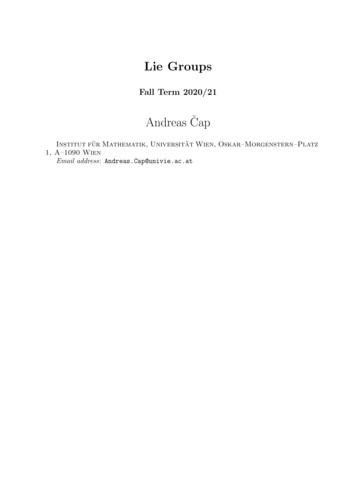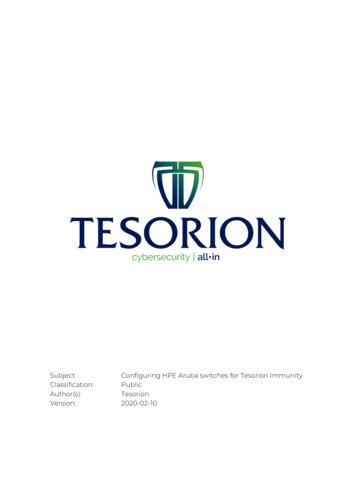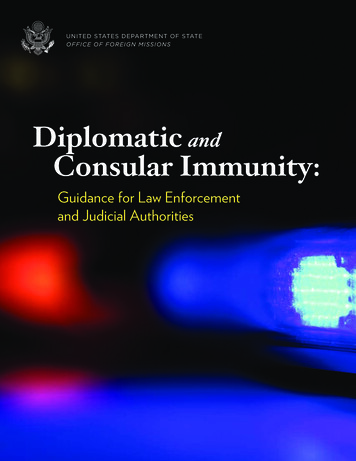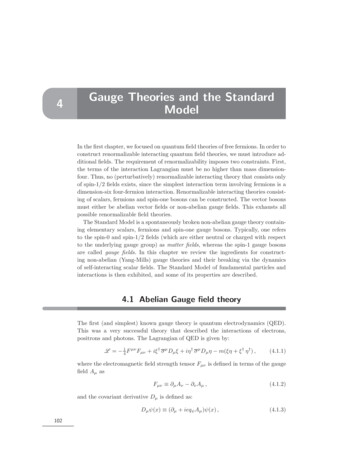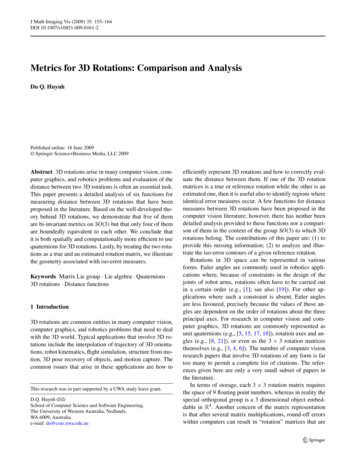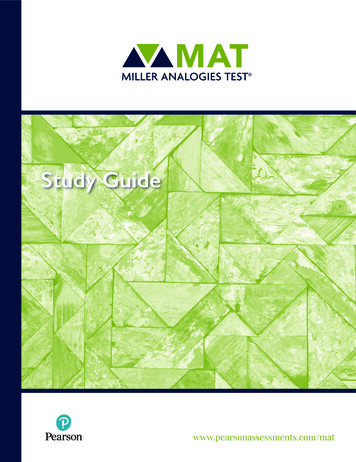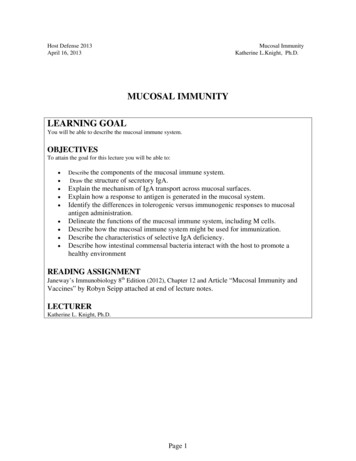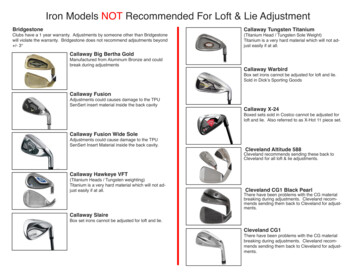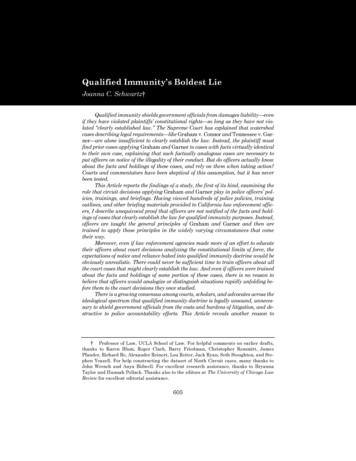
Transcription
Qualified Immunity’s Boldest LieJoanna C. Schwartz†Qualified immunity shields government officials from damages liability—evenif they have violated plaintiffs’ constitutional rights—so long as they have not violated “clearly established law.” The Supreme Court has explained that watershedcases describing legal requirements—like Graham v. Connor and Tennessee v. Garner—are alone insufficient to clearly establish the law. Instead, the plaintiff mustfind prior cases applying Graham and Garner to cases with facts virtually identicalto their own case, explaining that such factually analogous cases are necessary toput officers on notice of the illegality of their conduct. But do officers actually knowabout the facts and holdings of these cases, and rely on them when taking action?Courts and commentators have been skeptical of this assumption, but it has neverbeen tested.This Article reports the findings of a study, the first of its kind, examining therole that circuit decisions applying Graham and Garner play in police officers’ policies, trainings, and briefings. Having viewed hundreds of police policies, trainingoutlines, and other briefing materials provided to California law enforcement officers, I describe unequivocal proof that officers are not notified of the facts and holdings of cases that clearly establish the law for qualified immunity purposes. Instead,officers are taught the general principles of Graham and Garner and then aretrained to apply those principles in the widely varying circumstances that cometheir way.Moreover, even if law enforcement agencies made more of an effort to educatetheir officers about court decisions analyzing the constitutional limits of force, theexpectations of notice and reliance baked into qualified immunity doctrine would beobviously unrealistic. There could never be sufficient time to train officers about allthe court cases that might clearly establish the law. And even if officers were trainedabout the facts and holdings of some portion of these cases, there is no reason tobelieve that officers would analogize or distinguish situations rapidly unfolding before them to the court decisions they once studied.There is a growing consensus among courts, scholars, and advocates across theideological spectrum that qualified immunity doctrine is legally unsound, unnecessary to shield government officials from the costs and burdens of litigation, and destructive to police accountability efforts. This Article reveals another reason to† Professor of Law, UCLA School of Law. For helpful comments on earlier drafts,thanks to Karen Blum, Roger Clark, Barry Friedman, Christopher Kemmitt, JamesPfander, Richard Re, Alexander Reinert, Lou Reiter, Jack Ryan, Seth Stoughton, and Stephen Yeazell. For help constructing the dataset of Ninth Circuit cases, many thanks toJohn Wrench and Anya Bidwell. For excellent research assistance, thanks to BryannaTaylor and Hannah Pollack. Thanks also to the editors at The University of Chicago LawReview for excellent editorial assistance.605
606The University of Chicago Law Review[88:605reconsider the doctrine and, especially, its requirement that plaintiffs find clearlyestablished law.INTRODUCTION . 606I. QUALIFIED IMMUNITY’S EXPECTATION THAT OFFICERS KNOW “CLEARLYESTABLISHED LAW”. 613A. The Evolution of Qualified Immunity. 613B. Officers’ Assumed Notice of and Reliance on Clearly EstablishedLaw . 618II. “CLEARLY ESTABLISHED LAW” ON POLICE USE OF FORCE . 622III. WHAT POLICE KNOW ABOUT “CLEARLY ESTABLISHED LAW”. 629A. Methodology . 631B. Policies . 635C. Trainings . 6391. Basic training. 6402. In-service training. . 6443. Instructor training. 6534. Supplemental trainings and videos. . 657D. Government Attorneys . 658E. Legal Updates . 662IV. THE ROLE OF CASE LAW IN OFFICERS’ DECISIONMAKING. 664A. The Challenge of Learning Clearly Established Law . 664B. The Limited Role of Case Law in Police Education . 666C. Officers’ Ability to Recall Court Decisions on the Job . 668V. MOVING FORWARD . 673A. The Case Against Qualified Immunity . 673B. Possible Reforms . 6771. End qualified immunity. . 6772. Redefine “clearly established law.” . 678C. A Path Forward for Lower Courts . 682CONCLUSION . 683INTRODUCTIONIn Greek myths, heroes are regularly sent off on extraordinary quests. King Pelias ordered Jason and the Argonauts tobring back the fleece of the golden-haired, winged ram so that Jason could claim the throne of Iolcus in Thessaly.1 Hercules, cursedby Hera, and enslaved by Eurystheus, was ordered to perform1See generally EDITH HAMILTON, The Quest of the Golden Fleece, in MYTHOLOGY117 (New American Library ed. 1953) (1942).
2021]Qualified Immunity’s Boldest Lie607twelve labors—several of which required him to capture creaturesthat desperately did not want to get got, including the wild boarof Mount Erymanthus, the mad bull that terrorized the island ofCrete, the man-eating mares of King Diomedes, the cattle of thethree-bodied giant Geryon, and the triple-headed dog, Cerberus,from the underworld.2The Supreme Court’s qualified immunity doctrine sendsplaintiffs off on similarly far-flung pursuits. Qualified immunityshields government officials from damages liability—even whenthey have violated the law—so long as the right was not “clearlyestablished.”3 The Court has said that, except in extraordinarycircumstances, the law is clearly established only if a prior casehas declared the conduct unconstitutional.4 And that prior casemust have facts that map neatly onto the facts of the plaintiff’scase.5 The Supreme Court has repeatedly emphasized that it isnot enough simply to point to Graham v. Connor6 and Tennesseev. Garner7—two Supreme Court cases that set out frameworks forassessing the constitutionality of uses of force—to show it wasclearly established that a law enforcement officer’s use of forcewas unconstitutional. Instead, the plaintiff must produce a casein which another law enforcement officer used a similar type anddegree of force under similar circumstances, and was held to haveviolated the Constitution.8To find a factually similar case is a challenge on its own—particularly given the unending number of ways government2See generally EDITH HAMILTON, Hercules, in MYTHOLOGY, supra note 1, at 159.Harlow v. Fitzgerald, 457 U.S. 800, 818 (1982).4Although the Court held, in Hope v. Pelzer, 536 U.S. 730, 739–45 (2002), and againin Taylor v. Riojas, 141 S. Ct. 52, 54 (2020), that a prior court decision is not necessary toclearly establish the law when the constitutional violation is “obvious,” the Court has interpreted this exception narrowly. See infra notes 34–38 and accompanying text.5See infra notes 42–51 and accompanying text.6490 U.S. 386, 396–97 (1989) (holding that Fourth Amendment excessive forceclaims turn on whether the officer’s conduct was “‘objectively reasonable’ in light of thefacts and circumstances confronting them,” taking into consideration “the severity of thecrime at issue, whether the suspect poses an immediate threat to the safety of the officersor others, and whether he is actively resisting arrest or attempting to evade arrest byflight”).7471 U.S. 1, 3, 11–12 (1985) (holding that deadly force could not be used against“an apparently unarmed suspected felon . . . unless it is necessary to prevent the escapeand the officer has probable cause to believe that the suspect poses a significant threat ofdeath or serious physical injury to the officer or others”).8See infra notes 47–56 and accompanying text (describing Supreme Court casessetting out this requirement).3
608The University of Chicago Law Review[88:605officials can violate people’s constitutional rights. But the Supreme Court has made the search for clearly established law evenmore formidable by allowing lower courts to grant qualified immunity without ruling on the merits of plaintiffs’ claims.9 As FifthCircuit Judge Don Willett put it: “No precedent no clearly established law no liability. An Escherian Stairwell. Heads defendants win, tails plaintiffs lose.”10 King Eurystheus couldn’thave divined a better riddle.The Supreme Court’s qualified immunity doctrine has beencriticized six ways from Sunday—for bearing no resemblance tocommon law protections in effect when 42 U.S.C. § 1983 becamelaw, undermining government accountability, and failing toachieve the doctrine’s intended policy goals.11 The Court’s definition of “clearly established law” has also received its fair share ofcriticism. Commentators have argued that the Court’s decisionshave provided unclear and shifting guidance about how factuallysimilar a case must be to clearly establish the law and whichcourts’ decisions can clearly establish the law.12 Commentatorshave also argued that the “clearly established” standard protectsofficers who have outrageously abused their power simply because no prior decision has declared that conduct unlawful.13 AsProfessor John Jeffries has observed, the existence of precedentis not a good indicator of the wrongfulness of conduct, and trulyawful conduct can be shielded from liability so long as no courthas previously declared that conduct unconstitutional.14 “It is,”9See Pearson v. Callahan, 555 U.S. 223, 227 (2009).Zadeh v. Robinson, 902 F.3d 483, 499 (5th Cir. 2018) (Willett, J., concurringdubitante).11 See generally Joanna C. Schwartz, The Case Against Qualified Immunity, 93NOTRE DAME L. REV. 1797 (2018) (describing these critiques); see also infra notes 244–46and accompanying text (same).12 See, e.g., Karen Blum, Erwin Chemerinsky & Martin A. Schwartz, Qualified Immunity Developments: Not Much Hope Left for Plaintiffs, 29 TOURO L. REV. 633, 653–56(2013) (describing shifting standards for clearly established law); Alan K. Chen, The Intractability of Qualified Immunity, 93 NOTRE DAME L. REV. 1937, 1948–51 (2018) (describing confusion about how factually analogous prior court decisions must be to clearly establish the law); John C. Jeffries, Jr., What’s Wrong with Qualified Immunity?, 62 FLA. L.REV. 851, 854–59 (2010) (describing confusion about which sources can clearly establishthe law and how factually analogous prior cases must be to clearly establish the law).13 See Jeffries, supra note 12, at 854–58, 863–66; John C. Jeffries, Jr., The LiabilityRule for Constitutional Torts, 99 VA. L. REV. 207, 256–58 (2013); see also Michael L. Wells,Qualified Immunity After Ziglar v. Abbasi: The Case for a Categorical Approach, 68 AM.U. L. REV. 379, 436–38 (2019).14 Jeffries, supra note 13, at 255–56.10
2021]Qualified Immunity’s Boldest Lie609Jeffries writes, “as if the one-bite rule for bad dogs started overwith every change in weather conditions.”15In this Article, I offer another reason that the “clearly established” standard is fundamentally flawed—it misunderstands theways in which officers are educated about the scope of their constitutional authority. Qualified immunity’s requirement thatplaintiffs produce clearly established law is intended to shieldgovernment officials from damages liability unless they had “fairwarning”16 or “fair notice”17 of the unlawfulness of their conduct.The Court has instructed lower courts that watershed constitutional decisions like Graham and Garner do not provide officerswith adequate warning or notice about the limits of their authority.18 Instead, the Court’s qualified immunity decisions explain,officers have fair warning that their conduct is unconstitutionalonly if a court previously held that factually similar conduct exceeded constitutional bounds.19 By holding that only factuallysimilar precedent can put officers on notice of the unconstitutionality of their conduct—thereby clearly establishing the law—theCourt appears to assume that officers are educated not only aboutwatershed decisions like Graham and Garner, but also about thelower court decisions that apply Graham and Garner to a multitude of factual scenarios.20Nowhere in the Court’s decisions is consideration given tohow, exactly, police officers are expected to learn about the factsand holdings of the hundreds—if not thousands—of SupremeCourt, circuit court, and district court opinions that could be usedto clearly establish the law for qualified immunity purposes. Sustained consideration of this question is also absent from scholarlycommentary, although some have made mention of the implausibility of the Court’s assumption that officers know about thesecourt decisions.21 Nor has much consideration been given to thelikelihood that police officers recall the facts and holdings of these15Id. at 256.Hope, 536 U.S. at 740–41.17 Brosseau v. Haugen, 543 U.S. 194, 198 (2004).18 See infra notes 47–52 and accompanying text.19 See infra notes 52–65 and accompanying text.20 See infra Part I.B.21 See, e.g., John F. Preis, Qualified Immunity and Fault, 93 NOTRE DAME L. REV.1969, 1971 (2018) (“Appellate opinions are, not surprisingly, rarely read by governmentofficers and, even when their substance is communicated to officers, they only compriseone of many factors that affect the blameworthiness of an officer.”).16
610The University of Chicago Law Review[88:605hundreds or thousands of cases as they are making split-seconddecisions about whether to stop and frisk someone, search a car,or shoot their gun.22In this Article, I show that—in addition to its many otherflaws—the Supreme Court’s qualified immunity doctrine does notaccurately reflect how officers are educated about court opinionsor the role these opinions play in officers’ decisionmaking. I haveexamined hundreds of use-of-force policies, trainings, and othereducational materials received by California law enforcement officers.23 I find that police departments regularly inform their officers about watershed decisions like Graham and Garner. Butofficers are not regularly or reliably informed about court decisions interpreting those decisions in different factual scenarios—the very types of decisions that are necessary to clearly establishthe law about the constitutionality of uses of force.California police department policy manuals reference or incorporate the constitutional standards from Graham and Garner,but rarely reference any cases in which Graham and Garner wereapplied.24 California police officer trainings similarly focus primarily on the broad principles articulated in Graham and Garner.25 More than three-fourths of the 329 training outlines I reviewed referenced no court decision applying Graham and/orGarner. Even when training outlines do reference such cases, theoutlines suggest that trainers do not educate officers about theirfacts and holdings. Instead, these cases are introduced for broadprinciples that build on Graham and Garner: the notion, for example, that an officer does not need to use the least force possible,so long as the force used was reasonable.26 Trainings do, regularly, incorporate hypotheticals as a way to help officers developan understanding about whether force is appropriate in various22 For one notable exception, see Manzanares v. Roosevelt Cnty. Adult Det. Ctr., 331F. Supp. 3d 1260, 1293 n.10 (D.N.M. 2018) (“It strains credulity to believe that a reasonable officer, as he is approaching a suspect to arrest, is thinking to himself: ‘Are the factshere anything like the facts in York v. City of Las Cruces?’”).23 For discussion of my reasons for focusing on use-of-force decisions, see infra notes128–31 and accompanying text. For discussion of my reasons for focusing on Californiaofficers, see infra notes 118–21 and accompanying text.24 For further discussion of these findings, see infra Part III.B.25 For further discussion of these findings, see infra Part III.C.26 See infra notes 148–69 and accompanying text (discussing training outlines thatuse Ninth Circuit cases to illustrate this point).
2021]Qualified Immunity’s Boldest Lie611scenarios. But the outlines offer no indication that these scenariosare drawn from court cases.Police officers are not reliably learning about use-of-forcecases applying Garner and Graham from other sources, either.27District attorneys and city attorneys do not appear to train officers about the facts and holdings of court decisions that clearly establish the law for qualified immunity purposes. There are ahandful of e-mail newsletters available to law enforcement officers that describe court decisions relevant to law enforcement. Buteven these newsletters provide scattershot information aboutuse-of-force cases, and there is no requirement that California officers subscribe to and read them. In sum, California police officers are not regularly or reliably given warning or fair notice of thefacts and holdings of court decisions that apply Graham andGarner.Moreover, even if law enforcement relied more heavily oncourt decisions to educate their officers about the constitutionallimits of force, the expectations of notice and reliance baked intoqualified immunity doctrine would still be unrealistic. Therecould never be sufficient time to train officers about the hundreds—if not thousands—of court cases that could clearly establish the law for qualified immunity purposes. Moreover, even ifan officer did somehow come to learn about the facts and holdingsof court decisions applying Graham and Garner, there is no reason to believe that an officer would think about those cases duringthe types of high-speed, high-stress interactions that often lead touses of force.28 At best, court decisions are one of many sources ofinformation that officers have about the limits of appropriate behavior. And all available evidence suggests that people cannotsort through the complex information contained in court decisionsin the types of high-pressure circumstances that often precede police uses of force.Qualified immunity doctrine is, rightfully, being attackedfrom all sides. When the Court or Congress does finally reconsiderqualified immunity, it should keep this Article’s findings inmind.29 And, until Congress or the Supreme Court takes action,27See infra Part III.C–D.For further discussion, see infra Part IV.29 States should also keep these findings in mind, as state legislatures considerwhether to enact causes of action that do not allow a qualified immunity defense, and statecourts consider whether qualified immunity applies to existing state law causes of action.28
612The University of Chicago Law Review[88:605lower courts should remember, when considering qualified immunity motions, that officers are not given notice of the cases thatdefendants argue are necessary to clearly establish the law. Police officers are put on notice of the Supreme Court’s watersheddecisions—like Graham and Garner—but not about the circuitand district court opinions that apply those decisions. It thereforemakes no sense to require plaintiffs to plumb the depths ofWestlaw for factually similar lower court decisions as proof thatofficers were on notice of the unconstitutionality of their conduct.Requiring plaintiffs to find factually similar cases sends them onextraordinary journeys comparable to heroes’ quests, but does notadvance the stated goals of qualified immunity.The remainder of the Article proceeds as follows. Part I describes qualified immunity and the expectation embedded in thedoctrine that officers know about the decisions that apply watershed cases like Graham and Garner to various factual scenarios.Part II offers an overview of the landscape of clearly establishedlaw in one area: Ninth Circuit Fourth Amendment excessive forcecases interpreting Graham and Garner. As this Part shows, thereare hundreds of cases interpreting the scope of constitutionalrights in this one area, in this one circuit, suggesting that therecould be thousands of cases that clearly establish the law regarding the constitutional bounds of California officers’ conduct. Yet,as I show in Part III, the facts and holdings of these cases interpreting Graham and Garner play virtually no role in Californiapolice policies, trainings, and other educational materials. Moreover, as I show in Part IV, the expectations of notice upon whichqualified immunity doctrine relies would not be met even if officers were better educated about these cases. Officers could neverlearn the facts and holdings of the hundreds or thousands of casesthat clearly establish the law and, even if they learned about someof these cases, they would not reliably recall their facts and holdings while doing their jobs. Finally, in Part V, I consider the implications of these findings for the future of qualified immunity.See, e.g., Nick Sibilla, Colorado Passes Landmark Law Against Qualified Immunity, Creates New Way to Protect Civil Rights, FORBES (June 21, 2020), https://perma.cc/5UKR-CZM4 (describing a Colorado law that creates a new “civil action for deprivation of rights”and states that “qualified immunity is not a defense to liability,” as well as court decisionsthat have limited qualified immunity’s applicability to state law claims (quotation marksomitted) (quoting Enhance Law Enforcement Integrity Act, S.B. 20-217, 72d Gen. Assemb., 2d Reg. Sess. (Colo. 2020))).
2021]Qualified Immunity’s Boldest Lie613I. QUALIFIED IMMUNITY’S EXPECTATION THAT OFFICERS KNOW“CLEARLY ESTABLISHED LAW”Qualified immunity doctrine did not always require thatplaintiffs identify circuit court or Supreme Court decisions withvirtually identical facts before allowing them to recover. In thisPart, I describe the evolution of qualified immunity doctrine fromits inception to the present day, then describe two key assumptions underlying the doctrine: that officers know about SupremeCourt and courts of appeals decisions applying broad constitutional principles set out in cases like Graham and Garner to various factual scenarios, and that officers recall and rely on the factsand holdings of those decisions while on the job.A. The Evolution of Qualified ImmunityIn 1967, when the Supreme Court created the qualified immunity defense, it shielded officers from damages liability if theywere acting in “good faith.”30 But today’s qualified immunity doctrine has nothing to do with officers’ good faith. In 1982, in a casecalled Harlow v. Fitzgerald,31 the Court eliminated considerationof an officer’s subjective intent, and instead instructed lowercourts to grant officers qualified immunity if their conduct did notviolate “clearly established law.”32 Current Supreme Court doctrine suggests that an officer violates clearly established law onlyif there is a prior court of appeals or Supreme Court decision holding virtually identical facts to be unconstitutional.33 In this Section, I explain how the Court’s definition of “clearly establishedlaw” has evolved from 1982 to the present day, both in terms ofwhat sources can clearly establish the law and how factually similar prior court decisions must be to the case at hand.The Court has offered shifting guidance about whether acourt decision is necessary to clearly establish the law. In 2002,the Court held, in Hope v. Pelzer,34 that a prior court opinion withsimilar facts was unnecessary to clearly establish that it was unconstitutional for prison guards to punish a prisoner by shackling3031323334Pierson v. Ray, 386 U.S. 547, 557 (1967).457 U.S. 800 (1982).Id. at 818.See infra notes 42–56 and accompanying text.536 U.S. 730 (2002).
614The University of Chicago Law Review[88:605him to a hitching post for seven hours under the Alabama sun.35In 2020, the Court, in Taylor v. Riojas,36 ruled that a prior courtopinion with similar facts was unnecessary to clearly establishthat it was unconstitutional to confine a prisoner for six days in“shockingly unsanitary cells” covered in feces and sewage.37 But—beyond these two decisions involving the torturous treatment ofstate prisoners—the Court’s decisions have paid only lip serviceto the notion that constitutional rights can be clearly establishedwithout a prior case on point and have repeatedly required thatplaintiffs identify court decisions to overcome a qualified immunity motion.38The Court has also offered shifting guidance about whichcourts can clearly establish the law. In 1999, the Court explainedthat a plaintiff must identify a case of “controlling authority intheir jurisdiction at the time of the incident” or a “consensus ofcases of persuasive authority” to defeat a qualified immunity motion.39 In recent years, however, the Court has hinted—in opinions that only “[a]ssum[e] arguendo” that a decision by a courtother than the Supreme Court can clearly establish the law—thatnot even courts of appeals cases will reliably do the trick.40Although neither the Supreme Court nor lower courts have35Id. at 738–46.141 S. Ct. 52 (2020).37 Id. at 53.38 Beyond the Court’s decision in Riojas, and a citation to Hope when describing thequalified immunity standard in Tolan v. Cotton, 572 U.S. 650, 656 (2014), the Court’s invocations of Hope’s language have been in dissent. See, e.g., Kisela v. Hughes, 138 S. Ct.1148, 1158 (2018) (Sotomayor, J., dissenting) (“[O]fficials can still be on notice that theirconduct violates established law even in novel factual circumstances.” (citing Hope, 536U.S. at 741)); Mullenix v. Luna, 136 S. Ct. 305, 314 (2015) (Sotomayor, J., dissenting)(“This Court has rejected the idea that ‘an official action is protected by qualified immunityunless the very action in question has previously been held unlawful.’ Instead, the crux ofthe qualified immunity test is whether officers have ‘fair notice’ that they are acting unconstitutionally.” (first quoting Anderson v. Creighton, 483 U.S. 635, 640 (1987); and thenquoting Hope, 536 U.S. at 739)).39 Wilson v. Layne, 526 U.S. 603, 617 (1999).40 Reichle v. Howards, 566 U.S. 658, 665 (2012); see also, e.g., Carroll v. Carman, 135S. Ct. 348, 350 (2014) (“Assuming for the sake of argument that a controlling circuit precedent could constitute clearly established federal law in these circumstances, Marascodoes not clearly establish that Carroll violated the Carmans’ Fourth Amendment rights.”(citation omitted)); City & County of San Francisco v. Sheehan, 135 S. Ct. 1765, 1776(2015) (“[E]ven if ‘a controlling circuit precedent could constitute clearly established federal law in these circumstances,’ it does not do so here.” (citation omitted) (quoting Carroll,135 S. Ct. at 350)); City of Escondido v. Emmons, 139 S. Ct. 500, 503 (2019) (“Assumingwithout deciding that a court of appeals decision may constitute clearly established lawfor purposes of qualified immunity . . . .”).36
2021]Qualified Immunity’s Boldest Lie615limited their qualified immunity analyses to Supreme Court decisions, the Court’s musings about which courts can clearly establish the law have created uncertainty on this point.41The Court has also gotten stricter about how factually analogous prior precedent must be in order to clearly establish the law.In 1999, the Court explained that law was clearly established if itwas “sufficiently clear that a reasonable official would understand that what he is doing violates that right.”42 But then, in2011, in Ashcroft v. al-Kidd,43 the Court substituted “every” for“a,” such that “every ‘reasonable official’” would now need to understand that their conduct violates the law.44 Although the Courthas repeatedly assured plaintiffs that it “do[es] not require a casedirectly on point,” it has also repeatedly instructed lower courts“not to define clearly established law at a high level of generality”when considering a qualified immunity motion.45 “The dispositivequestion,” the Court has written, “is ‘whether the violative natureof particular conduct is clearly established’” and “[t]his inquiry‘must be undertaken in light of the specific context of the case, notas a broad general proposition.’”46In the use-of-force context, this has come to mean that, in theSupreme Court’s words, “Garner and Graham do not by themselves create clearly established law outside ‘an obvious case.’”47For example, the Supreme Court made clear in Brosseau v.Haugen48 that it was not enough to ask whether it was clearlyestablished that a police officer may use deadly force only“[w]here the officer has probable cause to believe that the suspectposes a threat of serious physical harm, either to the officer or toothers.”49 Instead, the correct inquiry, according to the Cou
2021] Qualified Immunity's Boldest Lie 609 Jeffries writes, "as if the one-bite rule for bad dogs started over with every change in weather conditions."15 In this Article, I offer another reason that the "clearly estab-lished" standard is fundamentally flawed—it misunderstands the
